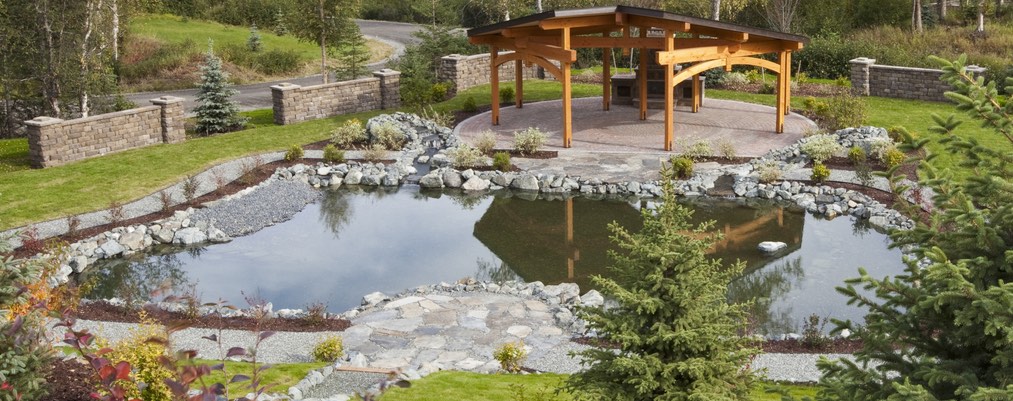
Acreages give you room to create special features.
Acreage Owners
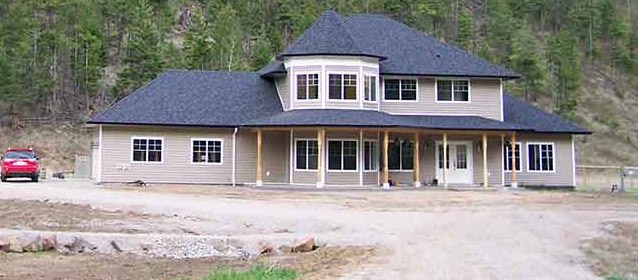
Starting with a blank canvas can be daunting...
I see landscaping as a performing art -- like a play; rather than as a fine art -- like a sculpture. Every year I make changes in my yard -- add a tree here -- take out one that I put under the power line, change the lily bed into an iris bed, This summer I need to add something around the base of my rocky mountain junipers. The bottom is looking a bit ragged as the older branches die. Seeing landscape as performing art means every year is fresh, and the work is no longer a chore, but an artistic endeavor. It's also giving me a new perspective on time and patience.
You have a new acreage. Maybe new new. Your landscape is tastefully done in the finest quality mud, or you have a 10 acres corner of what was a canola field two summers ago. Maybe just new to you. If you found this page, you want to add something a bit more ambitious than grass.
It's not going to get done this year.
If you take my performance art idea, it will never be complete, but each year will have it's own rewards.
Before you plant that tree some things to consider:
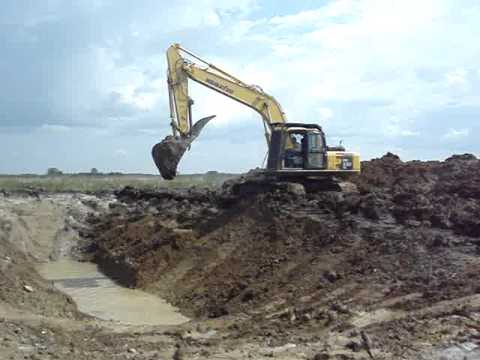
Big dirt moving is fast, efficient, but less than nimble. Do this First
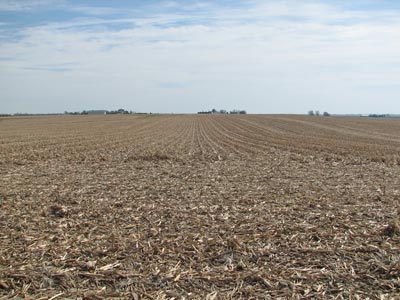
You may be starting from this.
Or worse.
Moving Earth
If you are ever going to put in a water feature, add a hill, make a pond, get all the equipment part of that done this year. You can get a track hoe and operator for about $2000/day, and that will give you something like a quarter acre pond. You will probably also need a cat for a day to spread the pile. They are cheaper. You don't have to do all the landscaping for the pond/stream, but you want all the work that requires anything bigger than a bobcat done. Big equipment isn't delicate.
Ponds increase the resale value a bunch. They also are a hazard for small kids: be ready to fence too. Pig fence and T bar stakes can fence it in in an afternoon, and the fence is almost invisible, but it makes mowing difficult. Make it a wiggly fence and put a path with one edge into the fence.
Deal with the Clay
If the developer left lots of clay on the surface this is also the year to deal with that. Add some top soil. Plant vetch or alfalfa on it. When it is nearly finished blooming, and starts to develop seed, rototil it in and plant buckwheat. When the buckwheat finishes flowering, till it in and plant fall rye. The key here: Don’t let the green manure crops go to seed. Each generation will starve a generation of weeds, as well as turn clay into something like soil.
During the late fall, haunt the alleys and steal bags of leaves. You want about 3-4 bags per ping pong table, more conventionally, half bag per square yard. I use two utility trailer loads of leaves a year just on my garden.
Stack them in the corner or build compost bins and start them composting. (This makes for less work in the spring, and if done right, the heat of the composting will kill any imported weed seeds.) There are whole books on the art and science of composting. Try MotherEarthNews.com
In spring, spread leaves 6" thick or compost 1/2-1" thick whereever you want to grow stuff. Rototil in with a generous doses of fertilizer. If dry, water. Wait two weeks for the next crop of weeds to start, and till again, and plant your lawn/garden whatever.
If the soil is really stubborn, you may need to do this legume, buckwheat, rye cycle a couple of times. More information about cover crops and weed supression at MotherEarthNews.com and Rodale.com
This is also the time to plan WHERE the decks and patios will be. Or at least where they might be. It's a real nuisance to plant a tree then discover that you want a deck there, and have to either move the tree, cut down the tree or build the deck around the tree. (That can be cool, but don't plant a tree that has lots of messy fruit.)
This may mean you don't plant any trees this year, or at least not as many. No matter what else you have to sacrifice, plant at least ONE. This is symbolic of your new life in your new house.
Of course depending on how big your lot is, you may be able to put windbreaks in on the edges this year.
What size of trees?
Broadly speaking trees are like the bears in Goldilock's biography. Small medium and large.
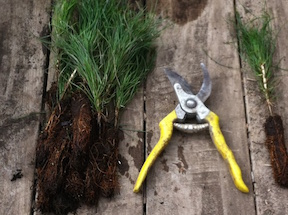
Seedlings: Cheap, but small, and take a lot of care the first two years.
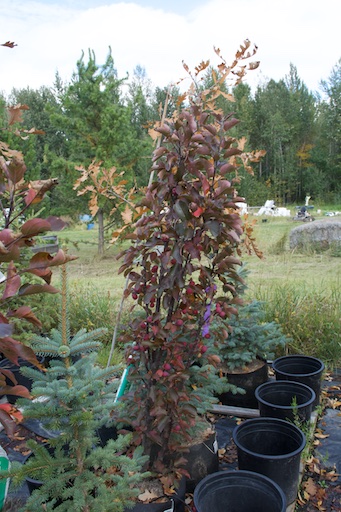
It's not really a tree until you have to look up at the top.
This is a 1.25" caliper Emerald Spire Crabapple about 7 feet tall.
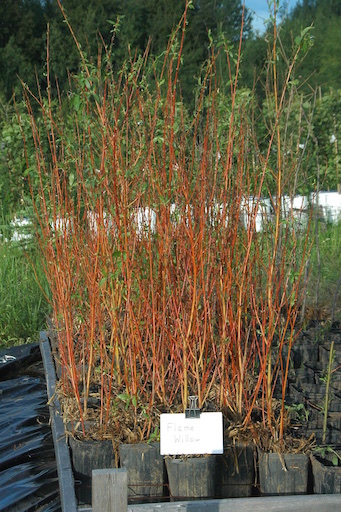
Medium size trees are still easily planted in a few minutes. But they are bigger than the weeds.
Seedlings:
Cheap, Easy to plant. But high mortality rate, easy to mow, easy to step on. Hard to find in the weeds. Long time to get big. Under $2 per tree when you are buying lots of them.
Caliper trees:
These are ones that are at least an inch across 6" up the trunk. Eight to fifteen feet tall. Plant them with a bobcat and tree spade or a back hoe. Expensive to buy, expensive to plant. Typically $300 to $700 by the time all is done. And some of them will die.
Caliper trees are mostly field grown. They are lifted with a tree spade and put in wire baskets or lifted with a potting spade and put in a pot. In either case most of the roots are in the field. This is stressful. The rule of thumb is that the tree will sit there for a year for each inch diameter. Depending on the source and the care of planting, about 1/3 of them die. If you buy a caliper tree, get the seller to plant it and get a two year guarantee.
Potted trees:
These are the middle of the pack. Midsize in price. $10 to $100. They come in a pot ranging from about 3 quarts (a 'trade gallon' or #1) to a #15 about 12 real gallons. The latter is about 150 lbs. A #7 pot (5 gallon pail) is about the biggest that can easily planted alone. Ideally a potted tree has been in an pot all it's life. However many potted trees at garden centres were in the field a couple months ago. Sometimes garden center trees will have a root ball that completely falls apart when you remove the pot. Not to worry. Plant it with care, and stake with 3 stakes. Pay more attention to packing the soil firmly around the tree. Repoted trees are supposed to be in their new pot for a growing season before being transplanted again, but this doesn't always happen. Again -- the warranty is your friend.
Midsize trees are 3 feet to 7 feet tall. They are big enough to see from the back of a speeding mower. Small enough to plant by yourself without paying for your chiropractor's next Burmuda holiday.
Most of my trees are small and midsize trees. The majority have been in a pot all their
lives, and have a solid well established root system.
I prefer to sell you midsize trees. More
of them will live. This is not a rush thing. And
since my trees are container grown, you can plant almost any
time from May to October.
Seedlings have their place; I sell them because some people want them. It's easy to add a few extra to my order. I mostly sell them to keep my name in the public eye. I don't carry basketed trees. My largest trees are the bottom end of the caliper range. If it won’t fit in a #15 pot, I don’t grow it. (Trunk diameter of at least 1.5 inches) they are too big for my set up at this time, and too big for most people to plant by themselves.
Many people with an acreage are on a pretty tight budget -- All their spare cash was in the down payment. And there's always a pile of unexpected expenses shortly after moving in. If you can afford it, there's lots to be said for getting a few caliper trees from a landscape company just 'cuz. I'd suggest spending a third of your budget on big trees. It gives you hope, while waiting for the shrimps to catch up. I recommend Holes in St. Alberta or The Big Greenhouse in Spruce Grove, or Mill Creek Nursery. There are doubtless many others, but these are the places I go when I want a new tree for the yard that I don't grow myself.
In your planning, don't crowd it too much. Small trees look lost when they are 15 feet apart, but 20 years from now they are just right. If it's too much space, put shrubs between them. The tree will eventually crowd them out. And even a 10-15 year old shrub can be moved with a shovel, time and sweat.
I have both permanent and temporary trees. (Eh? Temp trees? A temp tree is one you plant for fast results while the permanent trees grow in. Poplar, willow, birch are temp trees -- they only last 30-60 years, and can be cut down later for firewood. But they grow fast -- 3-4 feet per year, more with supplementary water and fertilizer, and good weed control.)
Got something to say? Email me: sfinfo@sherwoods-forests.com
Interesting? Share this page.
Want to talk right now? Call me: (8 am to 8 pm only, please) 1-780-848-2548
Do not arrive unannounced. Phone for an appointment. Why? See Contact & Hours That same page gives our hours of operation.
Back to Top
Copyright © 2008 - 2021 S. G. Botsford
Sherwood's Forests is located about 75 km southwest of Edmonton, Alberta. Please refer to the map on our Contact page for directions.
